Blog categories
Blog archive
RSS Blog posts tagged with 'Living'
Blog Filters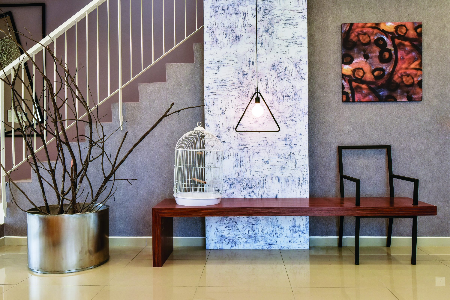
5 Ways to Make Your Living Room Stand Out with Unique Decorating Features
Friday, November 20, 2020
Besides being places of temporary respite, the average living room offers the kind of space that would be suited for small art installations rivalling high street galleries. Here are five ways to take advantage of any extra space in your seating lounge, to turn them into exhibits of artistic expression.
 Interior design by: Casa Indah Design
1. Arte Ensemble
Interior design by: Casa Indah Design
1. Arte Ensemble
Combine a collection of both common objects and unrelated rarities for an artful and dramatic arrangement that straddles surrealist and dadaist expression. In the decorative corner of this living room decorated by Casa Indah Design, a briskly-whitewashed panel acts as a country-inspired backdrop for a collection of seemingly unrelated objects presented on a piece of furnishing in the midst of an existential dilemma.
 Interior design by: Casa Indah Design
2. Style Fusion
Interior design by: Casa Indah Design
2. Style Fusion
It takes a certain boldness to combine unrelated themes into a cohesive interior, as was done in this living room - with furnishings of modern and minimalist designs located in close proximity to decorations reminiscent of the countryside. A dispersed sprinkling of country-inspired decorations, in the hide rug as well as both hard and soft representations of wood, help to tie together the two ordinarily contrasting themes.
 Interior design by: The Roof Studio
3. Overt Focus
Interior design by: The Roof Studio
3. Overt Focus
The modern convention presented in this living room is given an artful twist with the inclusion of a single armchair nestled into the inside of a mask. The stoic human face, formed out of the armchair's high back, surprises the naive eye and adds a dose of eccentricity to a relatively reserved interior appointed with modern and minimalist furnishings.
 Interior design by: Homlux Interior Furnishing
4. Discrete Organics
Interior design by: Homlux Interior Furnishing
4. Discrete Organics
The unified colour palette and fine lines of this elegant interior are complemented by natural forms presented in tight clutches of flora and a solitary statuette depicting a wild cat. The sandstone shade of these architectural finishes and furnishings contribute towards a tone reminiscent of the desert, creating potential for an oasis to be painted - as demonstrated by the tiny potted plants contained within glass bell covers on the paradoxically luxurious and minimalist coffee table.
 Interior design by: Jashen Interior Design
5. Vintage Homage
Interior design by: Jashen Interior Design
5. Vintage Homage
Expressions of style in architectural finishes can only say so much, rather than stopping with planes of homogenous finishes in brick and wood, this home office embraces vibes of the past by presenting a collection of plaques in vintage designs over the walls and cabinet doors.
Click here for more living rooms.

Luminous Elevations: How to Choose Lighting for Double-Height Living Rooms
Friday, November 20, 2020
The volume of air that comes with double-height ceilings typically calls for the use of impressive lighting fixtures that do more than just provide illumination - they inevitably become one of the focal points of attraction in living spaces. We combed through some delectable mansions, bungalows, duplexes, and penthouses to put this guide together and help you pick out the ideal chandelier (or other lighting fixture) to suit the extra-high ceiling of your décor.
Classical Chandeliers Equally appropriate in classical interiors as for lending an eccentric streak to modern settings, the many variations of glass or crystalline, and shaded or bare chandeliers are a requisite feature for anyone wanting a dependable style choice that can add a layer of elegance to a wide range of interiors.
 A classically inspired chandelier is a safe option to lend an aura of elegance to transitional or eclectic décors. Designer: The Roof
A classically inspired chandelier is a safe option to lend an aura of elegance to transitional or eclectic décors. Designer: The Roof
Curved Chandeliers A more common type of modern chandelier spotted in transitional and minimalist settings, the curved surfaces make for lower profile fixtures that do not intrude into the airspace. By virtue of their curved profiles and small size, many identical pieces can be hung together in staggered lines to depict heavenly bodies.
 Occupying less space than a conventional chandelier, the relatively small size of these metallic orbs enables the arrangement of multiple pieces in an array. Designer: Turn Design Interior
Occupying less space than a conventional chandelier, the relatively small size of these metallic orbs enables the arrangement of multiple pieces in an array. Designer: Turn Design Interior
Large-Scale Floor Lamps Take advantage of the abundance in ceiling space by incorporating an extra tall, floor-mounted lighting fixture. An imposing floor lamp represents an alternative focal point on an unanticipated plane and helps to preserve the volume of air provided by the high ceiling.
 The abundance of airspace in double-height spaces invites the use of over-sized floor mounted lighting fixtures. Designer: Turn Design Interior
The abundance of airspace in double-height spaces invites the use of over-sized floor mounted lighting fixtures. Designer: Turn Design Interior
Wall-Mounted Lights Maximize the conservation of airspace in your living room with low-profile lights mounted to walls. This arrangement can be used to highlight decorative walls higher up in the void while providing adequate task lighting and without hampering the intimate mood.
 Instead of an intrusive lighting fixture hanging in mid-air, this space presents discrete wall-mounted lights to produce an intimate atmosphere. Designer: IDS Interior
Instead of an intrusive lighting fixture hanging in mid-air, this space presents discrete wall-mounted lights to produce an intimate atmosphere. Designer: IDS Interior
Slim Spotlights If the dim illumination provided by wall-mounted lights is inadequate, or if you just want to highlight decorative furnishings nearer to the floor, consider using simple down-lights to obscure ceiling features in favour of highlighting furnishings on the ground.
 Pursuing a recording studio motif, this living room features utilitarian and low-profile down-lights to retain the sense of volume in this space. Designer: Motto Designs
Pursuing a recording studio motif, this living room features utilitarian and low-profile down-lights to retain the sense of volume in this space. Designer: Motto Designs
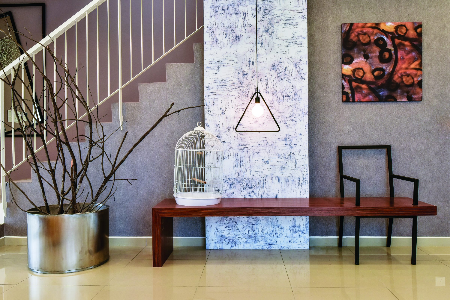
5 Ways to Make Your Living Room Stand Out with Unique Decorating Features
Friday, November 20, 2020
Besides being places of temporary respite, the average living room offers the kind of space that would be suited for small art installations rivalling high street galleries. Here are five ways to take advantage of any extra space in your seating lounge, to turn them into exhibits of artistic expression.
 Interior design by: Casa Indah Design
1. Arte Ensemble
Interior design by: Casa Indah Design
1. Arte Ensemble
Combine a collection of both common objects and unrelated rarities for an artful and dramatic arrangement that straddles surrealist and dadaist expression. In the decorative corner of this living room decorated by Casa Indah Design, a briskly-whitewashed panel acts as a country-inspired backdrop for a collection of seemingly unrelated objects presented on a piece of furnishing in the midst of an existential dilemma.
 Interior design by: Casa Indah Design
2. Style Fusion
Interior design by: Casa Indah Design
2. Style Fusion
It takes a certain boldness to combine unrelated themes into a cohesive interior, as was done in this living room - with furnishings of modern and minimalist designs located in close proximity to decorations reminiscent of the countryside. A dispersed sprinkling of country-inspired decorations, in the hide rug as well as both hard and soft representations of wood, help to tie together the two ordinarily contrasting themes.
 Interior design by: The Roof Studio
3. Overt Focus
Interior design by: The Roof Studio
3. Overt Focus
The modern convention presented in this living room is given an artful twist with the inclusion of a single armchair nestled into the inside of a mask. The stoic human face, formed out of the armchair's high back, surprises the naive eye and adds a dose of eccentricity to a relatively reserved interior appointed with modern and minimalist furnishings.
 Interior design by: Homlux Interior Furnishing
4. Discrete Organics
Interior design by: Homlux Interior Furnishing
4. Discrete Organics
The unified colour palette and fine lines of this elegant interior are complemented by natural forms presented in tight clutches of flora and a solitary statuette depicting a wild cat. The sandstone shade of these architectural finishes and furnishings contribute towards a tone reminiscent of the desert, creating potential for an oasis to be painted - as demonstrated by the tiny potted plants contained within glass bell covers on the paradoxically luxurious and minimalist coffee table.
 Interior design by: Jashen Interior Design
5. Vintage Homage
Interior design by: Jashen Interior Design
5. Vintage Homage
Expressions of style in architectural finishes can only say so much, rather than stopping with planes of homogenous finishes in brick and wood, this home office embraces vibes of the past by presenting a collection of plaques in vintage designs over the walls and cabinet doors.
Click here for more living rooms.
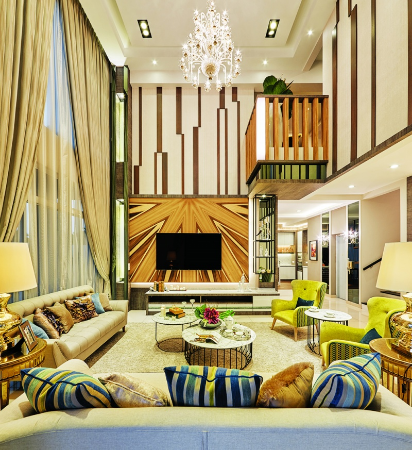
Luminous Elevations: How to Choose Lighting for Double-Height Living Rooms
Friday, November 20, 2020
The volume of air that comes with double-height ceilings typically calls for the use of impressive lighting fixtures that do more than just provide illumination - they inevitably become one of the focal points of attraction in living spaces. We combed through some delectable mansions, bungalows, duplexes, and penthouses to put this guide together and help you pick out the ideal chandelier (or other lighting fixture) to suit the extra-high ceiling of your décor.
Classical Chandeliers Equally appropriate in classical interiors as for lending an eccentric streak to modern settings, the many variations of glass or crystalline, and shaded or bare chandeliers are a requisite feature for anyone wanting a dependable style choice that can add a layer of elegance to a wide range of interiors.
 A classically inspired chandelier is a safe option to lend an aura of elegance to transitional or eclectic décors. Designer: The Roof
A classically inspired chandelier is a safe option to lend an aura of elegance to transitional or eclectic décors. Designer: The Roof
Curved Chandeliers A more common type of modern chandelier spotted in transitional and minimalist settings, the curved surfaces make for lower profile fixtures that do not intrude into the airspace. By virtue of their curved profiles and small size, many identical pieces can be hung together in staggered lines to depict heavenly bodies.
 Occupying less space than a conventional chandelier, the relatively small size of these metallic orbs enables the arrangement of multiple pieces in an array. Designer: Turn Design Interior
Occupying less space than a conventional chandelier, the relatively small size of these metallic orbs enables the arrangement of multiple pieces in an array. Designer: Turn Design Interior
Large-Scale Floor Lamps Take advantage of the abundance in ceiling space by incorporating an extra tall, floor-mounted lighting fixture. An imposing floor lamp represents an alternative focal point on an unanticipated plane and helps to preserve the volume of air provided by the high ceiling.
 The abundance of airspace in double-height spaces invites the use of over-sized floor mounted lighting fixtures. Designer: Turn Design Interior
The abundance of airspace in double-height spaces invites the use of over-sized floor mounted lighting fixtures. Designer: Turn Design Interior
Wall-Mounted Lights Maximize the conservation of airspace in your living room with low-profile lights mounted to walls. This arrangement can be used to highlight decorative walls higher up in the void while providing adequate task lighting and without hampering the intimate mood.
 Instead of an intrusive lighting fixture hanging in mid-air, this space presents discrete wall-mounted lights to produce an intimate atmosphere. Designer: IDS Interior
Instead of an intrusive lighting fixture hanging in mid-air, this space presents discrete wall-mounted lights to produce an intimate atmosphere. Designer: IDS Interior
Slim Spotlights If the dim illumination provided by wall-mounted lights is inadequate, or if you just want to highlight decorative furnishings nearer to the floor, consider using simple down-lights to obscure ceiling features in favour of highlighting furnishings on the ground.
 Pursuing a recording studio motif, this living room features utilitarian and low-profile down-lights to retain the sense of volume in this space. Designer: Motto Designs
Pursuing a recording studio motif, this living room features utilitarian and low-profile down-lights to retain the sense of volume in this space. Designer: Motto Designs
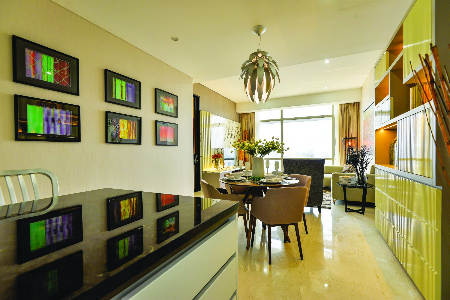
10 Ideas for Combining Your Dining and Living Spaces
Friday, November 20, 2020
Beyond just arranging dining and living room furniture sets near each other, there are a host of other considerations that one should look into when combining these two functionally separate areas.
 Interior design by: Kuzoj
Interior design by: Kuzoj
With space at a premium in urban homes, combining two of the areas that often take up the most space is a practical way of freeing up room for other functions. But things can get a little busy and cluttered when combining dining and living areas in small spaces such as a studio apartment or a home with an open floor plan. In light of the many ways that this merging can be achieved, we took a look at the most notable combined spaces we have seen over the years and extracted the base ingredients for your perusal here.
1. Grouped Arrangements
If you have the space to spare in your open plan home, the easiest way to combine the dining room with seating lounge is to position the respective furniture into two separate but adjacent groups - with an empty gap for a walkway between the two groups providing a means of access and to act as subtle demarcation.
 Interior design by: SQFT Space Design Management
Interior design by: SQFT Space Design Management
2. Narrow Spaces
For a comfortable dining experience, diners need between 90cm to 1.3m of space to be able to pull out a chair and take a seat, with around 60cm to 70cm of space between each seat for adequate elbow room. If space is limited, opt for a narrow rectangular table to discretely occupy the space on one side of the seating lounge.
 Interior design by: Pocket Square
Interior design by: Pocket Square
3. Informal Seating
At the most extreme end of the scale, one could also go beyond merging dining and living areas, by having seating and dining table occupy the same space. Replacing chairs on one side of a dining table with an upholstered bench creates a casual setting for meals and enables one to forgo having a sofa set - if the comfort and formality are not to be missed.
 Interior design by: The Roof
Interior design by: The Roof
4. Wall Features
To rein in the surplus empty space in your open plan layout, build up false wall projections and turn them into shelving or see-through niches to provide a means of visual separation as well as a functional fixture for additional storage.
 Interior design by: Beata Home and Office Furnishing
Interior design by: Beata Home and Office Furnishing
5. Decorative Ceilings
Even the thinnest of wall façades will take up some space, if only a negligible amount. To clearly demarcate your combined dining and seating lounge without occupying any of the valuable floor space, consider forming borders on the ceilings to visually indicate the extents of the functionally separate areas.
 Interior design by: Design Base
Interior design by: Design Base
6. Island Bars
Even without a dry kitchen adjacent to the seating lounge, it is possible to incorporate bar-height counters or kitchen islands - along with some stools or chairs of appropriate height, to provide a dining space in close proximity. Opting for countertop dining makes for a casual dining experience, and frees up additional space for other uses, such as a more spacious seating lounge.
 Interior design by: Pins Studio
Interior design by: Pins Studio
 Interior design by: Luna Solutions
Interior design by: Luna Solutions
7. Raised Platforms
With a small measure of additional space in an open floor plan, a slightly raised wooden platform would serve to elevate, highlight, and to keep the dining space visually distinct from any nearby seating.
 Interior design by: Pins Studio
Interior design by: Pins Studio
8. Decorative Archways
Building up a decorative archway between dining and seating furniture is another space-efficient way of define the combined areas, but best results are achieved in wide spaces so as not to make the open floor plan appear cramped.
 Interior design by: D'Concepto Design
Interior design by: D'Concepto Design
9. Dividing Drapery
In lieu of features such as arches, shelving, or see-through niches, an opaque or transparent curtain can be drawn shut to provide a temporary privacy screen during meals, and opened between meals to preserve the spaciousness of the open layout.
 Interior design by: Zids Design
Interior design by: Zids Design
10. Unifying Style
Whatever the means you have chosen to apply in visually indicating the separate functions of your combined dining and seating area, a harmoniously applied decorative style will serve to unify the distinct spaces. A unifying style does not necessarily entail a repeated palette, as a cohesive décor can still be achieved with complementary colour pairs applied as interchangeable base and accent colours.
 Interior design by: Nu Infinity
Interior design by: Nu Infinity

Choosing Your Living Room Furniture
Friday, November 20, 2020
Before setting out on your journey of acquiring living room furniture, consider the function, size, orientation, and shape of the space - then the style, material, and colour of your furnishings.
Filling any blank canvas requires the poise and confidence of an accomplished artist, but there is so much more than one's creative pride at stake when it comes to the kind of space that imparts first impressions like the average living room does. There are minimalist furnishings that may render a large space empty, there are button-backed leather Chesterfields that can overwhelm an urban apartment, and then there are modern contemporary sofas that seem to fit anywhere.
 Image Credit: Design Base
Image Credit: Design Base
With all the available sizes and styles of furnishings available, you may find yourself hard pressed to assemble a cohesive arrangement with varied pieces from different manufacturers. Armed with this guide and the critical considerations it presents, we believe your next search for living room furniture will produce more effective results.
Function
The first thing to do before furnishing any space is to pose the question of what one intends to do with it. Is your home a hub for large clan gatherings or more likely reserved for a select few? The approaches to furnishing your living room would differ depending on whether you are assembling a bachelor pad hangout or a lounge for a large family - the latter typically requires more seating, including the requisite pair of matching armchairs for the matriarch and patriarch of the clan, while the former could be adequately furnished with a single sofa set in close proximity to a coffee table.
 Interior design by: Q1 Interior Concept
Interior design by: Q1 Interior Concept
Size
With the role of the living room decided, one would have to take a look at what space there is to work with. In addition to floor space, one should also consider the presence and height of walls demarcating the area. First of all, is the lounge part of an open plan concept or is it enclosed in walls? A room surrounded by walls limits ingress and egress options, making arrangements more dependant on the placement of walls - on the other hand, an open layout leaves more to the imagination.
 Interior design by: The Home Concept Furniture
Interior design by: The Home Concept Furniture
Secondly, does the height of the ceiling make for a double volume space? A double-height ceiling will enable the incorporation of furnishings with high profiles to take advantage of the extra airspace, while a conventional ceiling may require furnishings of lower height so as to not overwhelm the sense of volume.
Lastly, what is the traffic flow around the house going to look like? If the living room is located more at the core of the house, walkways between furnishings would have to be considered, less so if it is a secluded corner.
 Interior design by: The Roof Studio
Interior design by: The Roof Studio
Shape
In addition to the size of the living room, the shape of a space will have an effect on the furnishings you select. An especially long and narrow lounge may not benefit from many round furnishings placed in the centre, while a square room will appear rather empty with the majority of furnishings hugging the walls.
 Interior design by: ID Industries
Interior design by: ID Industries
There exists a number appearing in both natural and produced designs that have been found to be aesthetically pleasing since the Italian Renaissance - the golden ratio of 1.618 has often been used to produce compositions that are universally regarded as beautiful. Applying this ratio to your own compositions will almost certainly guarantee an appealing arrangement: if you have an especially long space, consider visually subdividing it with pieces of seating or table surfaces to achieve a space where the length divided by width produces a number approaching the golden ratio.
Orientation
Another factor with significant weight on the effect of your furnishings is the orientation of the space, which affects the amount of sunlight your living room receives as the sun transits across the sky during the day. Material choices for your furnishings could be swayed by varying levels of sunlight at different times of day, so we recommend keeping a few sample swatches around to compare before settling on a material. Coupled with the consideration of natural lighting is the presence of windows providing scenic views - furnishings with low profiles may be considered to preserve the view, while high-backed seating could be made less intrusive by being positioned against a wall.
 Interior design by: The Roof Studio
Interior design by: The Roof Studio
Style
Prior considerations with regard to the function, size, shape, and orientation of the living room are less controllable - but the choice of style for your furnishings is where your personality will be more obviously presented. Before settling on your choice of furnishings, decide on whether you want your living room to be dedicated to the hallmarks of particular styles, such as the traditional trappings of classical style or dispense with all the frills for a minimalist decor - or maybe you would want to consider putting together your own unique assembly to present a more eccentric image.
 Interior design by: The Home Concept Furniture
Interior design by: The Home Concept Furniture
Materials
The choice of material for your furnishing is largely dependant on the function of the space, the lighting levels, and the style you want to achieve. Metal and wood frames are compatible with a wide range of styles, with reflective surfaces being more suited for spaces with a modern lean. Suede and fabric upholstery may be delectable to the senses, but tougher materials like leather may be more suitable in homes with children or pets.
 Interior design by: Surface R
Interior design by: Surface R
Colour
It probably goes without saying that the shades and tones of your living room furniture should be selected according to your personal preference, albeit with attention paid to the subtle effects of colour on moods, the appearance of colours in changing light conditions, and matching or complementing furnishings with the base or accent colours in architectural finishes.
 Interior design by: X-Two Concept
Interior design by: X-Two Concept
Completely saturating a room in various shades of a single colour is an easy way to get around most of the additional considerations of matching or complementing with base or accent colours, while imposing into a space a favoured hue and its effects on mood.
 Interior design by: Gusto Design & Build
Interior design by: Gusto Design & Build
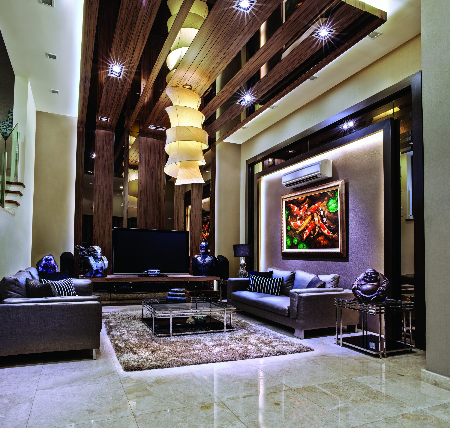
Stylish Vibes: 5 Ways to Style Your Living Room
Friday, November 20, 2020
Perhaps you’ve come across our pointers on incorporating artful decorations or storage into living rooms, and now find yourself wondering about how to assemble a décor to impress - if that’s the case, take a look at these five ways to create a stylish living room.
Asiatic Modernity
 Interior design by: Design Integra
Interior design by: Design Integra
A neutral palette is applied to the background of this seating lounge, rendered dark with the addition of wood in dusky shades across the wall and ceiling. Appointing the modern furnishings and architectural features are a collection of elements inspired by Oriental aesthetics: an oil-on-canvas depiction of Japanese carp in a feeding frenzy is framed in straight edges and cool white light, a fabric lampshade mimics the furls of the ghost fungi, and a prosperously-bellied laughing Buddha is playfully juxtaposed with the busts of characters conceived on the other side of the planet.
Studio Vibe
 Interior design by: Sachi Interior Design
Interior design by: Sachi Interior Design
An otherwise ordinary seating lounge furnished with highly versatile modern furnishings is given the personality of an urban art studio with the addition of curated decorations - a cropped reproduction of Audrey Hepburn’s visage, a Warhol-esque array of lips, and a standing light fixture appointed with a light-diffusing parasol speak of the resident’s affinity for photography.
Transitional Effects
 Interior design by: Metrics Global
Interior design by: Metrics Global
Where other living rooms dressed in modern style may appear nearly indistinguishable from each other, this seating lounge differentiates itself with a length of full-height mirrors that reflect the classical trim on the surrounding walls. Sprinklings of outdoor elements soften the straight-edged architectural finishes and contemporary furnishings to bridge the gap between modernity and the old world.
Diverse Influences
 Interior Design by: Nice Style Refurbishment
Interior Design by: Nice Style Refurbishment
An escapade from the compact nature of urban homes is constructed with the depictions of wood over a background of brick in an expansive decorative wall feature. Opposing this length of wall is a relatively plain image painted with a monochromatic palette to achieve a décor connecting elements of minimalism with the countryside.
Eclectic Arrangement
 Interior design by: Q1 Interior Concept
Interior design by: Q1 Interior Concept
Looking for something different? Elements of seemingly disparate influences converge on this seating lounge in idiosyncratic fashion. A lone armchair upholstered in a patchwork of patterned fabrics focuses attention on the prevailing theme, with the shades of orange and blue brought to the foreground in the shade of upholstery of the other seating furniture.
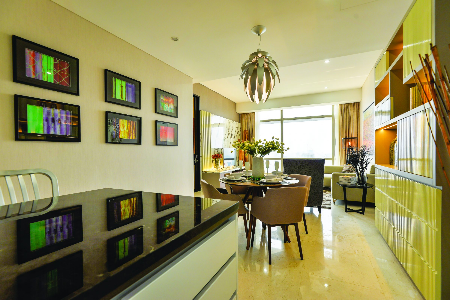
10 Ideas for Combining Your Dining and Living Spaces
Friday, November 20, 2020
Beyond just arranging dining and living room furniture sets near each other, there are a host of other considerations that one should look into when combining these two functionally separate areas.
 Interior design by: Kuzoj
Interior design by: Kuzoj
With space at a premium in urban homes, combining two of the areas that often take up the most space is a practical way of freeing up room for other functions. But things can get a little busy and cluttered when combining dining and living areas in small spaces such as a studio apartment or a home with an open floor plan. In light of the many ways that this merging can be achieved, we took a look at the most notable combined spaces we have seen over the years and extracted the base ingredients for your perusal here.
1. Grouped Arrangements
If you have the space to spare in your open plan home, the easiest way to combine the dining room with seating lounge is to position the respective furniture into two separate but adjacent groups - with an empty gap for a walkway between the two groups providing a means of access and to act as subtle demarcation.
 Interior design by: SQFT Space Design Management
Interior design by: SQFT Space Design Management
2. Narrow Spaces
For a comfortable dining experience, diners need between 90cm to 1.3m of space to be able to pull out a chair and take a seat, with around 60cm to 70cm of space between each seat for adequate elbow room. If space is limited, opt for a narrow rectangular table to discretely occupy the space on one side of the seating lounge.
 Interior design by: Pocket Square
Interior design by: Pocket Square
3. Informal Seating
At the most extreme end of the scale, one could also go beyond merging dining and living areas, by having seating and dining table occupy the same space. Replacing chairs on one side of a dining table with an upholstered bench creates a casual setting for meals and enables one to forgo having a sofa set - if the comfort and formality are not to be missed.
 Interior design by: The Roof
Interior design by: The Roof
4. Wall Features
To rein in the surplus empty space in your open plan layout, build up false wall projections and turn them into shelving or see-through niches to provide a means of visual separation as well as a functional fixture for additional storage.
 Interior design by: Beata Home and Office Furnishing
Interior design by: Beata Home and Office Furnishing
5. Decorative Ceilings
Even the thinnest of wall façades will take up some space, if only a negligible amount. To clearly demarcate your combined dining and seating lounge without occupying any of the valuable floor space, consider forming borders on the ceilings to visually indicate the extents of the functionally separate areas.
 Interior design by: Design Base
Interior design by: Design Base
6. Island Bars
Even without a dry kitchen adjacent to the seating lounge, it is possible to incorporate bar-height counters or kitchen islands - along with some stools or chairs of appropriate height, to provide a dining space in close proximity. Opting for countertop dining makes for a casual dining experience, and frees up additional space for other uses, such as a more spacious seating lounge.
 Interior design by: Pins Studio
Interior design by: Pins Studio
 Interior design by: Luna Solutions
Interior design by: Luna Solutions
7. Raised Platforms
With a small measure of additional space in an open floor plan, a slightly raised wooden platform would serve to elevate, highlight, and to keep the dining space visually distinct from any nearby seating.
 Interior design by: Pins Studio
Interior design by: Pins Studio
8. Decorative Archways
Building up a decorative archway between dining and seating furniture is another space-efficient way of define the combined areas, but best results are achieved in wide spaces so as not to make the open floor plan appear cramped.
 Interior design by: D'Concepto Design
Interior design by: D'Concepto Design
9. Dividing Drapery
In lieu of features such as arches, shelving, or see-through niches, an opaque or transparent curtain can be drawn shut to provide a temporary privacy screen during meals, and opened between meals to preserve the spaciousness of the open layout.
 Interior design by: Zids Design
Interior design by: Zids Design
10. Unifying Style
Whatever the means you have chosen to apply in visually indicating the separate functions of your combined dining and seating area, a harmoniously applied decorative style will serve to unify the distinct spaces. A unifying style does not necessarily entail a repeated palette, as a cohesive décor can still be achieved with complementary colour pairs applied as interchangeable base and accent colours.
 Interior design by: Nu Infinity
Interior design by: Nu Infinity
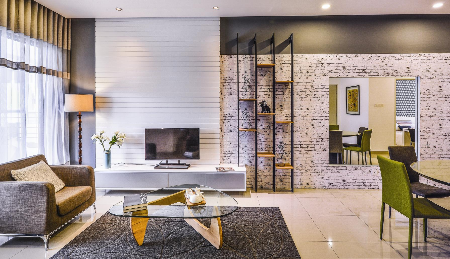
Choosing Your Living Room Furniture
Friday, November 20, 2020
Before setting out on your journey of acquiring living room furniture, consider the function, size, orientation, and shape of the space - then the style, material, and colour of your furnishings.
Filling any blank canvas requires the poise and confidence of an accomplished artist, but there is so much more than one's creative pride at stake when it comes to the kind of space that imparts first impressions like the average living room does. There are minimalist furnishings that may render a large space empty, there are button-backed leather Chesterfields that can overwhelm an urban apartment, and then there are modern contemporary sofas that seem to fit anywhere.
 Image Credit: Design Base
Image Credit: Design Base
With all the available sizes and styles of furnishings available, you may find yourself hard pressed to assemble a cohesive arrangement with varied pieces from different manufacturers. Armed with this guide and the critical considerations it presents, we believe your next search for living room furniture will produce more effective results.
Function
The first thing to do before furnishing any space is to pose the question of what one intends to do with it. Is your home a hub for large clan gatherings or more likely reserved for a select few? The approaches to furnishing your living room would differ depending on whether you are assembling a bachelor pad hangout or a lounge for a large family - the latter typically requires more seating, including the requisite pair of matching armchairs for the matriarch and patriarch of the clan, while the former could be adequately furnished with a single sofa set in close proximity to a coffee table.
 Interior design by: Q1 Interior Concept
Interior design by: Q1 Interior Concept
Size
With the role of the living room decided, one would have to take a look at what space there is to work with. In addition to floor space, one should also consider the presence and height of walls demarcating the area. First of all, is the lounge part of an open plan concept or is it enclosed in walls? A room surrounded by walls limits ingress and egress options, making arrangements more dependant on the placement of walls - on the other hand, an open layout leaves more to the imagination.
 Interior design by: The Home Concept Furniture
Interior design by: The Home Concept Furniture
Secondly, does the height of the ceiling make for a double volume space? A double-height ceiling will enable the incorporation of furnishings with high profiles to take advantage of the extra airspace, while a conventional ceiling may require furnishings of lower height so as to not overwhelm the sense of volume.
Lastly, what is the traffic flow around the house going to look like? If the living room is located more at the core of the house, walkways between furnishings would have to be considered, less so if it is a secluded corner.
 Interior design by: The Roof Studio
Interior design by: The Roof Studio
Shape
In addition to the size of the living room, the shape of a space will have an effect on the furnishings you select. An especially long and narrow lounge may not benefit from many round furnishings placed in the centre, while a square room will appear rather empty with the majority of furnishings hugging the walls.
 Interior design by: ID Industries
Interior design by: ID Industries
There exists a number appearing in both natural and produced designs that have been found to be aesthetically pleasing since the Italian Renaissance - the golden ratio of 1.618 has often been used to produce compositions that are universally regarded as beautiful. Applying this ratio to your own compositions will almost certainly guarantee an appealing arrangement: if you have an especially long space, consider visually subdividing it with pieces of seating or table surfaces to achieve a space where the length divided by width produces a number approaching the golden ratio.
Orientation
Another factor with significant weight on the effect of your furnishings is the orientation of the space, which affects the amount of sunlight your living room receives as the sun transits across the sky during the day. Material choices for your furnishings could be swayed by varying levels of sunlight at different times of day, so we recommend keeping a few sample swatches around to compare before settling on a material. Coupled with the consideration of natural lighting is the presence of windows providing scenic views - furnishings with low profiles may be considered to preserve the view, while high-backed seating could be made less intrusive by being positioned against a wall.
 Interior design by: The Roof Studio
Interior design by: The Roof Studio
Style
Prior considerations with regard to the function, size, shape, and orientation of the living room are less controllable - but the choice of style for your furnishings is where your personality will be more obviously presented. Before settling on your choice of furnishings, decide on whether you want your living room to be dedicated to the hallmarks of particular styles, such as the traditional trappings of classical style or dispense with all the frills for a minimalist decor - or maybe you would want to consider putting together your own unique assembly to present a more eccentric image.
 Interior design by: The Home Concept Furniture
Interior design by: The Home Concept Furniture
Materials
The choice of material for your furnishing is largely dependant on the function of the space, the lighting levels, and the style you want to achieve. Metal and wood frames are compatible with a wide range of styles, with reflective surfaces being more suited for spaces with a modern lean. Suede and fabric upholstery may be delectable to the senses, but tougher materials like leather may be more suitable in homes with children or pets.
 Interior design by: Surface R
Interior design by: Surface R
Colour
It probably goes without saying that the shades and tones of your living room furniture should be selected according to your personal preference, albeit with attention paid to the subtle effects of colour on moods, the appearance of colours in changing light conditions, and matching or complementing furnishings with the base or accent colours in architectural finishes.
 Interior design by: X-Two Concept
Interior design by: X-Two Concept
Completely saturating a room in various shades of a single colour is an easy way to get around most of the additional considerations of matching or complementing with base or accent colours, while imposing into a space a favoured hue and its effects on mood.
 Interior design by: Gusto Design & Build
Interior design by: Gusto Design & Build
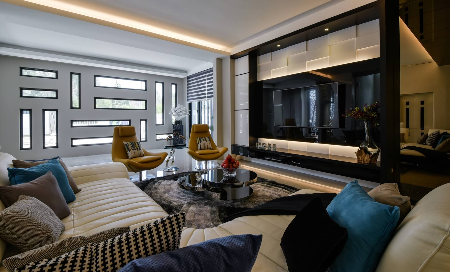
7 Ways to Make Your Living Room Unique
Friday, November 20, 2020
Great minds may think alike but few actually enjoy being the unwitting character in the trope of two party guests dressed the same. If you’ve ever experienced a disorientating wash of déjà vu when stepping into someone else’s living room, you may be interested in finding ways of differentiating your own space. In this guide, we take a look at the various avenues for creating uniqueness in your seating lounge.
Feature Walls
 Interior design by: GDY Design
Interior design by: GDY Design
Unless every piece of furniture is individually manufactured to your specific tastes, there’s a chance that the arrangement of your living room is similarly, if not identically, represented in someone else’s home. To differentiate the pictured seating lounge, GDY Design & Construction apply their creative impulses to the surrounding walls by relying only on a monochromatic palette and a simplistic brick motif. With the walls rendered unique, their efforts encapsulate the furniture arrangement in an environment that could only be duplicated with access to the designer's schematics.
High Ceilings
 Interior design by: Desigva Interior
Interior design by: Desigva Interior
Just as the oculus—the circular skylight at the apex of the Pantheon’s dome in Rome—has provided pilgrims and curious sightseers with spiritual experiences for over a millennium, an extra-height ceiling or an air-well appointed with generous windows and skylights will create entry points for sunlight. As the quality of sunlight varies over the course of the day, the tones of the pictured seating lounge are highlighted in various unique ways: the warm and ethereal light of sunrise and sunset accentuates the darker colours, while the brightness of midday emphasises the white background.
Aquascaping
 Interior design by: ID Industries
Interior design by: ID Industries
Beyond being an element of favourable geomancy (feng shui), an aquarium in the seating lounge is another dimension of decoration that can be altered over time much like a garden on dry land. ID Industries, the designers of the pictured living room, tactfully include a lush planted aquarium into a space dominated by grains of wood. This unique decorative feature extends the organic theme of the space, while simultaneously acting as a physical barrier in the open layout and providing a source of soft lighting that ripples with movements in the water.
Customised Shelving
 Interior design by: Shirley Yeong via Beata Home and Office Furniture
Interior design by: Shirley Yeong via Beata Home and Office Furniture
Slabs of marble are never identical, even when comparing two sequential cuts from the same rock face of the same quarry. Getting shelves made to specifications is perhaps one of the most common methods of differentiating a space, and opting for shelves made from marble adds a layer of uniqueness with the highly variable shades and veining patterns typical of most marbled stone. In the seating lounge pictured above, the customised marble display surfaces are combined with gilded accents, mirrored panels, and darkly stained wood to create a palatial space fit for royalty.
Floor Displays
 Interior design by: Mode Interior Style
Interior design by: Mode Interior Style
Where most would opt for a uniform expanse of seamless stone on the floors, an artistic display deliberately laid beneath one’s feet provides a surprising point of intrigue in the seating lounge. In the pictured living room decorated by Mode Interior Style, a Zen-inspired display of white river pebbles is contained within a raised dais of wood to demarcate the space and provide the naïve eye with an additional decorative feature to linger upon.
Musical Instruments
 Interior design by: Latitude Design
Interior design by: Latitude Design
Whether it is a museum piece or a more contemporary instrument made affordable by mass manufacturing, a musical instrument provides the potential for creative expression and draws attention in the same way that an unfinished painting in a gallery of finished works invites intrigue. The classically inspired décor of the pictured home is complemented by a ubiquitous grand piano of modern origin, but the auditory sensations that this instrument could produce render the space unique with the anticipation of a musical experience.
Dramatic Lighting
 Interior design by: Design Base
Interior design by: Design Base
Just as sunlight affects a space in highly varied ways through the day, artificial sources of light can also serve to accentuate colours and paint a living room in unique tones. As demonstrated by Design Base in the living room pictured above, a refined and carefully curated blend of architectural finishes, decorative features, and lighting result in a space that will not easily duplicated elsewhere. In this seating lounge, sheer curtains filter the sunlight to complement the pale wood floor, the white walls, and the ultraviolet tone of light emitted from concealed sources in the ceiling tray and around the feature wall.
Read a similar article in Mandarin here.





